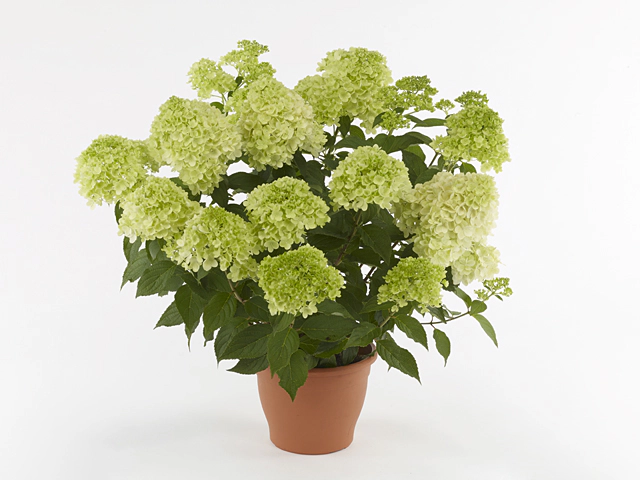Hydrangea paniculata Pantonella

| Flower type | Single |
| Winter hardness | Excellent (USDA-zone 1,2,3,4) |
| Flower color | White-white-NN155C; Green-light green-145D |
| Leaf, general shape | Elongate; Elliptic / oval |
| Petal edge | Entire |
| Flower diameter | 2,5 - 3 cm |
| Plant height | 80 - 90 cm; 90 - 100 cm |
| Inflorescence | Panicle |
| Flowering month(s) | September; October; June; July; August |
| Structure (tissues) | Subshrubby/semi-shrubby |
| Leaf duration | Deciduous |
| Leaf size | 7,5 - 10 cm |
| soil pH requirement | Alkaline (pH > 7,5); Neutral (pH 6,5 - 7,5); Slightly acidic (pH 4,5 - 6,5) |
| Light conditions | Sunny; Semi-shades |
| Inflorescence diameter | 10 - 15 cm |
| Leaf, main color | Dark green |
| Flower color distribution | Unicolored |
| Moisture requirements | Well-drained; Moist |
Hydrangea paniculata Pantonella, also known as HYDRANGEA, is an excellent choice for gardeners looking for a beautiful and hardy flowering plant. This particular hydrangea variety is known for its single flower type and its excellent winter hardiness, making it suitable for USDA zones 1, 2, 3, and 4.
The flowers of Hydrangea paniculata Pantonella are truly stunning, with a color palette that includes white-white (NN155C) and green-light green (145D). The flowers have a small diameter, ranging from 2.5 to 3 cm, and they feature entire petal edges. The inflorescence is in the form of a panicle, adding to the plant's visual appeal.
These hydrangeas typically reach a height of 80 to 90 cm, or for older plants, 90 to 100 cm. They are subshrubby or semi-shrubby in structure and have deciduous leaves. The leaves are elongate and elliptic/oval in shape, with a dark green color as their main hue. The average leaf size is around 7.5 to 10 cm.
When it comes to soil preferences, Hydrangea paniculata Pantonella is relatively adaptable. It can grow in alkaline soil with a pH above 7.5, neutral soil with a pH between 6.5 and 7.5, and slightly acidic soil with a pH ranging from 4.5 to 6.5. It is important to note that the plant thrives in well-drained soil conditions. However, it can also tolerate slightly moist soil, making it a versatile choice for different soil types.
Light conditions are another factor to consider when cultivating Hydrangea paniculata Pantonella. These plants prefer sunny to semi-shaded areas, where they can receive a good amount of sunlight but also have some protection from direct exposure. Striking the right balance between sunlight and shade will help ensure optimum growth and blooming.
The inflorescence of Hydrangea paniculata Pantonella has a diameter of 10 to 15 cm, creating a captivating display when the plant is in full bloom. The flowers have a unicolored distribution, adding to their overall aesthetic appeal. This particular variety of hydrangea tends to flower between the months of September and October, with some additional blooming in June, July, and August.
In conclusion, Hydrangea paniculata Pantonella is a remarkable flowering plant that offers not only beautiful blooms but also excellent winter hardiness. Its versatile adaptability to different soil pH levels and its preference for sunny to semi-shaded locations make it an ideal choice for gardeners of varying skill levels. With proper care and suitable conditions, this hydrangea will thrive and enhance the beauty of any garden or landscape.
Market availability index by month:
| Jan. | Feb. | Mar. | Apr. | May | Jun. | Jul. | Aug. | Sep. | Oct. | Nov. | Dec. |
|---|---|---|---|---|---|---|---|---|---|---|---|
| 1 | 1 | 1 | 2 | 2 | 2 | 4 | 3 | 1 | 1 | 1 | 1 |